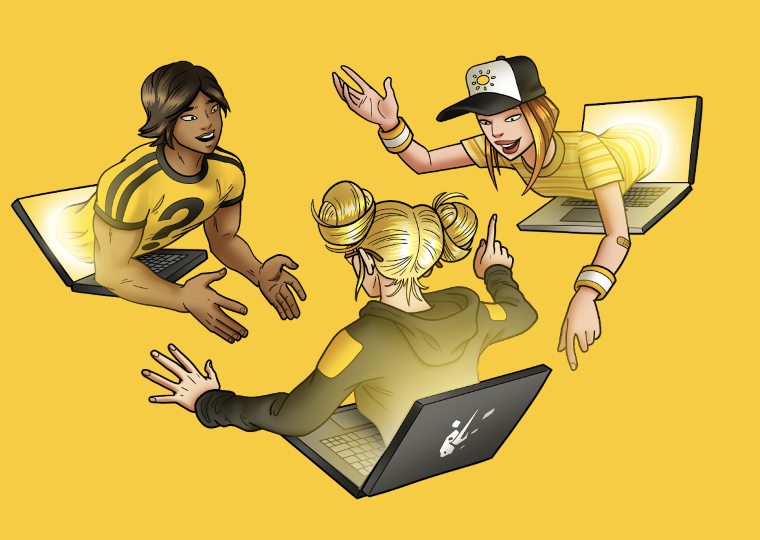.png)

At the heart of every meaningful learning experience lies human connection. It’s the debates around classroom tables, the late-night study groups, and the organic exchange of ideas that leave a lasting mark. Yet, as education increasingly integrates technology, many educators and students are left wondering—does AI mean the end of human interaction in learning? Breakout not only answers this question but also redefines it. By marrying artificial intelligence with the timeless power of peer interaction, Breakout offers a vision of education that’s both forward-thinking and deeply human.
The Power of Peer-to-Peer Connections
Human interaction has always been central to learning. From discussions in Socratic circles to debates in modern classrooms, real-time exchange is where ideas are challenged, refined, and solidified. Unlike passive textbook learning where engagement is one-dimensional, peer discussions force students to articulate their thoughts, defend their positions, and adapt when presented with new perspectives. This collaboration isn't just about knowledge—it's where essential life skills like empathy, teamwork, and clear communication are cultivated.
When students connect with each other, they find motivation outside of grades. They show up for the conversation, curious about what their peers think, eager to be heard, and ready to discuss. Human connection is what drives participation – students show up not because they’re told to, but because they value the interaction with their peers.
Why Traditional Models Fall Short in Modern Learning
Traditional education models are designed around individual tasks—reading a textbook, completing solitary problem sets, or writing essays to be silently graded. These methods prioritize content retention over the kind of critical engagement students crave. With this approach, students frequently disengage, seeing little value beyond ticking boxes for grades.
Today’s students are digitally native, with access to more information than any previous generation. What they lack is not content but connection. Breakout addresses this gap. By shifting the focus away from isolated tasks to conversation-driven learning, Breakout shifts the mold. Students who learn to collaborate, respond thoughtfully, and explore diverse viewpoints don't just perform better academically; they gain the skills necessary for success in the modern workforce.
Building Empathy and Collaboration in the Classroom
Soft skills like communication, collaboration, and empathy are often overlooked in traditional education models. Yet these skills are critical for the modern workforce, where teamwork and emotional intelligence often define success. Breakout places these skills at the center of its platform.
Each small-group discussion on Breakout’s platform is designed to encourage conversations that are inclusive and thought-provoking. By working through topics and refining their ideas, students develop not only a stronger grasp of the subject but also the ability to express themselves more effectively. The AI tracks behaviors—such as positively engaging with other group members—and provides immediate feedback. This isn’t just learning for the test; it’s preparing for life.
How Conversation-Driven Learning Transforms Education
Students want to feel heard. They want to know that their ideas matter and that they can engage with peers meaningfully. Breakout’s conversation-driven model transforms the classroom from static and passive to dynamic and energizing.
Before entering the classroom, students engage in small-group discussions through Breakout’s AI-powered platform. These discussions prep them for the material, forcing them to wrestle with key ideas and articulate their thoughts. By the time they step into class, students are already engaged, possessing varied perspectives shaped by their peers. This dynamic changes the classroom experience—no longer is the professor lecturing a quiet room. Instead, they guide active discussions where students are excited to contribute.
Technology That Strengthens Humanity
The fear that AI will replace human connection in education is real, and not entirely unfounded. But Breakout’s approach demonstrates that technology, when used right, can serve as a bridge rather than a barrier. By prioritizing human interaction and peer connection, Breakout creates a learning environment that is vibrant, engaging, and inherently human.
Our platform emphasizes collaboration while leveraging AI to address the challenges of scale and logistics. Breakout doesn’t remove the professor or reduce peer-to-peer exchanges—it enriches them. By moderating discussions, summarizing ideas, and lowering participation barriers for shy or hesitant students, Breakout ensures every student has a voice and an opportunity to learn from others.
The Future of Education Is Collaborative
Education isn’t just about consuming facts; it’s about engaging, exploring, and growing—together. Breakout recognizes that the classroom of the future isn’t powered by AI in isolation, but by combined efforts of technology and humanity.
Human connection matters in education because it’s from each other that students draw inspiration, challenge assumptions, and learn how to build a better world. Breakout amplifies these connections, honoring education’s foundational ethos while charting a path forward into a future where collaboration and community drive learning.
For those worried that technology alienates us, Breakout provides reassurance. The tools we build don’t have to divide—they can deepen our connections and redefine what’s possible in modern education.
Up next
.png)

Authentic Assessment Starts with Real Conversations (and AI)
The evolving field of education demands tools and techniques that align with modern learners' needs. Traditional methods of evaluation—think multiple-choice exams and essays—often fail to capture the depth and complexity of true learning. They assess...

We need to build our classrooms around discussions, not around lectures
For centuries, some of the most profound learning experiences have occurred not in vast lecture halls but around intimate circles of dialogue and exchange. From Socrates engaging his students in philosophy to our ancestors debating strategies around a...

